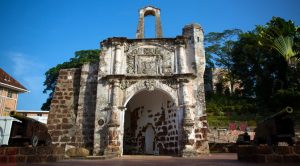Attractions in Historical Malacca, Malaysia
Malacca in Malaysia is truly a popular holiday destination and deserves more than just a short stopover as there are many interesting heritage areas worth visiting.
Geography and History of Malacca
Malacca is located on the southwestern coast of Peninsular Malaysia and is 148 km south of Kuala Lumpur, and 245 km north of Singapore. It covers an area of 1650 sq. km. The state capital Malacca Town is located between the two national capitals – Malaysia and Singapore, and is linked with excellent roads and highways.
Malacca’s history dates back to the 14th century with the arrival of the exiled Hindu prince Parameswara from Sumatra. He embraced Islam in 1414 and changed his name to Sultan Iskandar Shah. He became the first ruler of this new kingdom which marked the beginnings of Malacca Sultanate.
How Malacca Got its Name
One day while hunting, Parameswara saw a white mouse-deer kick one of his hunting dogs in self-defense and force it into the river. He was impressed by the mouse-deer’s courage and decided to build a city there, where the weak could triumph over the strong. He then gave it the name of the tree ‘Melaka’, under which he sat resting.
In collaboration with allies from the sea, Parameswara (Sultan Iskandar Shah) established Malacca as an international port. Malacca thus became the foremost maritime trading centre for merchants who came from Arabia, China, Europe, and India to trade in silk, spices, gold and porcelain. When he died in 1424, his son Sri Maharaja (Sultan Muhammad Shah) became his successor.
Mass Chinese Settlement and Rule of the Portuguese
In order to enhance relations, Hang Li Po of the Ming Emperor of China came with 500 attendants. While she married Sultan Mansoor Shah, her attendants married the locals. The Chinese who came as miners, traders, and coolies settled in large numbers near ‘Bukit China’ or the Chinese Hill.
Malacca became a major port along the spice-route. When it became prosperous, the Portuguese under the command of Alfonso de Albuquerque conquered Malacca in 1511 and ruled for 150 years. Some married the locals and stayed back. They formed a fishing community, now referred to as Portuguese-Eurasian or Kristang.
After the Portuguese, the Dutch ruled from 1614 for 150 years. The British took over from 1795 to 1802, and again from 1811 to 1818. After a brief spell of renewed control by the Dutch, the British again took control of Malacca in 1824. The state obtained independence in 1957, and after two decades became a fully industrialized state.
Malacca’s Portuguese-influenced Architecture and Chinese-influenced Streetlife
The influence of the Portuguese is seen maximum in Malacca’s architecture. Like always, they taxed buildings according to their width. A building could be up to maximum twelve feet across, but could extend backwards up to two hundred feet. And this explains the thin facades on the colonial streets. Inside, the houses had high ceilings and courtyards.
The Chinese influence is felt mostly on the streets of Malacca. Like always, the Chinese merchants advertise their wares with bright red colors. In the open air market which sells vegetables, fruits, and fish, Mandarin is the language spoken. There is also the largest Chinese graveyard on the edge of the city and the oldest Chinese temple – the Cheng Hoon Teng Temple. To cater to their needs, an industry in Malacca produces goods solely for the dead. Offerings like simulacra, multi-colored currency, cellular phones, computers, and the like, are bought to keep the spirits happy.
Malacca is a center of Peranakan culture. When Chinese settlers first came to Malacca as miners, traders and coolies, they married local women and adopted local customs. The Chinese and local Malay cultures in Malacca intertwined producing a completely unique society, the Baba-Nyonya. This reached its height around the turn of the century.
Sight Seeing in Malacca
Beauty preserved at its best, 600 years of its history is reflected in the town’s rich heritage buildings, ancient landmarks, colonial structures, cuisine, and streets.
Places to visit include A’ Famosa Resort, Auyin Hill Resort, Baba Nyonya Heritage Museum, Bird Aviary, Bukit China, Butterfly Farm, Cheng Kampung Kling Mosque, Chitty Museum, Christ Church, Crocodile Park, Dusun Tropika, Gadek Hot Springs, Hang Jebat & Hang Kasturi Mausoleums, Hang Li Po’s Well, Heeren Street, Jonker Walk, Koon Teng Chinese Temple, Malacca River, Malacca Sultanate Palace, Pintu Gerbang Ayer Keroh, Maritime Museum, Memorial Hall, St. Francis Xavier’s Church, St. John’s Fort, and many more.
Getting Here
By Road: Malacca is only a two-hour drive from Kuala Lumpur and two and half hours from Johar Bahru. Buses, air-conditioned coaches and taxis are easily available.
By Rail: The nearest railway station is at Tampin, 38 km from Malacca.
By Sea: Malacca is a favorite stop-over destination for cruise ships.
By Air: A small airfield some 9kms away from Malacca accommodates light aircrafts at Batu Berendam.
Getting Around
Taxis: At bus stations, hotels, and shopping complexes, taxis are available.
Bus: Local bus service is available.
Trishaw: is easily available.
Car: can be rented to travel with friends and family.
Bicycles: A common man’s friend can be hired and is an inexpensive mode of seeing the city.





